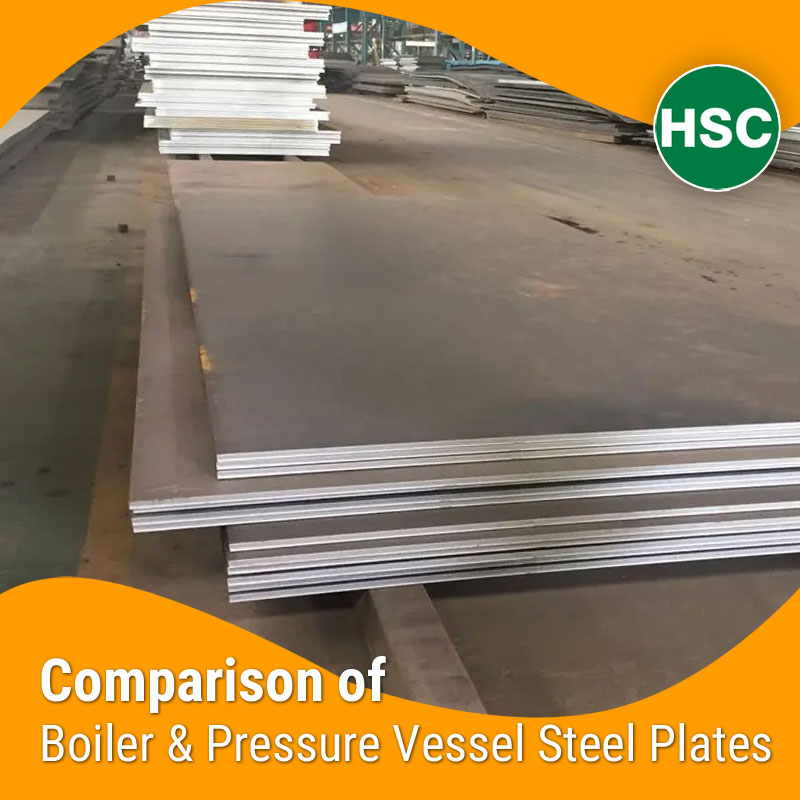A516 vs A387 – What’s the Real Difference?
If you’re choosing steel plates for a pressure vessel, ASTM A516 and ASTM A387 are the most compared materials.
- A516 = Carbon steel plates for moderate temperature service
- A387 = Chrome Moly alloy plates for elevated temperature & corrosion resistance
The right choice depends on temperature, pressure, corrosion, and project specs.
Basic Composition: Carbon vs Alloy Steel
| Grade | Base Type | Alloying Elements |
|---|---|---|
| A516 | Carbon Steel | Manganese |
| A387 | Alloy Steel | Chromium, Molybdenum (Cr-Mo) |
- A516 has better weldability and economy
- A387 has higher resistance to heat and corrosion
Where Are These Grades Used?
- A516: Steam boilers, tanks, heat exchangers
- A387: Oil refineries, thermal power plants, petrochemical reactors
Quick Use Case Reference
| Project | Use A516 If… | Use A387 If… |
|---|---|---|
| Low-to-mid temp boiler | Yes | No |
| High-temp reactor | No | Yes |
| Corrosive oil & gas fluids | Limited | Preferred |
| Budget is tight | Yes | No |
Mechanical Strength Comparison
| Property | A516 Gr 70 | A387 Gr 11 / 22 |
|---|---|---|
| Yield Strength | 260–285 MPa | 275–310 MPa |
| Tensile Strength | 485–620 MPa | 515–690 MPa |
| Elongation | ≥17% | ≥20% |
| Temp Resistance | Upto 450°C | Upto 600°C+ |
- A387 is superior for elevated temp service
- A516 is more flexible and cost-effective for moderate temperatures
Corrosion Resistance
- A387’s Cr-Mo content helps it resist hydrogen attack, sulfide stress cracking, and oxidation
- A516 is not designed for highly corrosive environments unless coated or clad
Standards and Equivalents
| ASTM Grade | Equivalent |
|---|---|
| A516 Gr 70 | IS 2041, EN 10028 P295GH |
| A387 Gr 11/22 | BS 1501, EN 10028-2 16Mo3, DIN 17155 HII |
Weldability and Fabrication
- A516 = Easier to weld and cut; used in many Indian fabrication shops
- A387 = Requires preheat/post-weld heat treatment due to alloying
Which Plate Should You Choose?
Choose A516 if:
✔ Budget is limited
✔ Temp ≤ 450°C
✔ No aggressive media or hydrogen
Choose A387 if:
✔ Temp ≥ 500°C
✔ Hydrogen or acidic gases present
✔ Long-term elevated temp service is needed
Why Buy from Hindustan Steel Corporation?
- Both grades A516 and A387 ready stock
- In-house cutting, forming, testing, and MTC issuance
- IBR-certified, HIC-tested, and third-party inspected material
- Supplied to NTPC, L&T, ISGEC, HPCL, Thermax
Available Grades & Sizes
| Grade | Thickness | Width | Length |
|---|---|---|---|
| A516 Gr 60/70 | 6–150 mm | 1250–2500 mm | 6–12 m |
| A387 Gr 11/22 Cl 2 | 6–100 mm | 1500–2500 mm | 6–12 m |
Custom cut-to-size and tested plates available with CE, EN 10204 3.1/3.2, and IBR forms.
Export-Ready Supply
We supply to:
- UAE, Saudi Arabia, Vietnam, South Africa
- With heat traceability, CE stamping, NACE, and HIC support
Certifications Provided
- EN 10204 3.1 / 3.2 MTC
- IBR Certificate (India)
- CE / PED marking on request
- NABL-tested impact & chemical report
Stock Availability at Hindustan Steel Corporation
- Ready stock of Gr 60 and Gr 70 up to 150 mm thick
- Custom-cut sizes available within 72 hours
- Full export documentation with HS Code 7225.40
FAQs for A516 vs A387
Which plate is better for high pressure?
A387 offers better performance at high pressure and high temperature.
Can A516 be used for elevated temperature?
Only up to ~450°C. For 500°C+, A387 is safer.
Is A387 more expensive than A516?
Yes. Due to alloying with Cr-Mo, A387 is costlier but more durable.
Which one is IBR approved?
Both A516 and A387 are available in IBR-approved versions.
Which one is better for acidic environments?
A387 is preferred due to better resistance to H2S and acidic corrosion.

